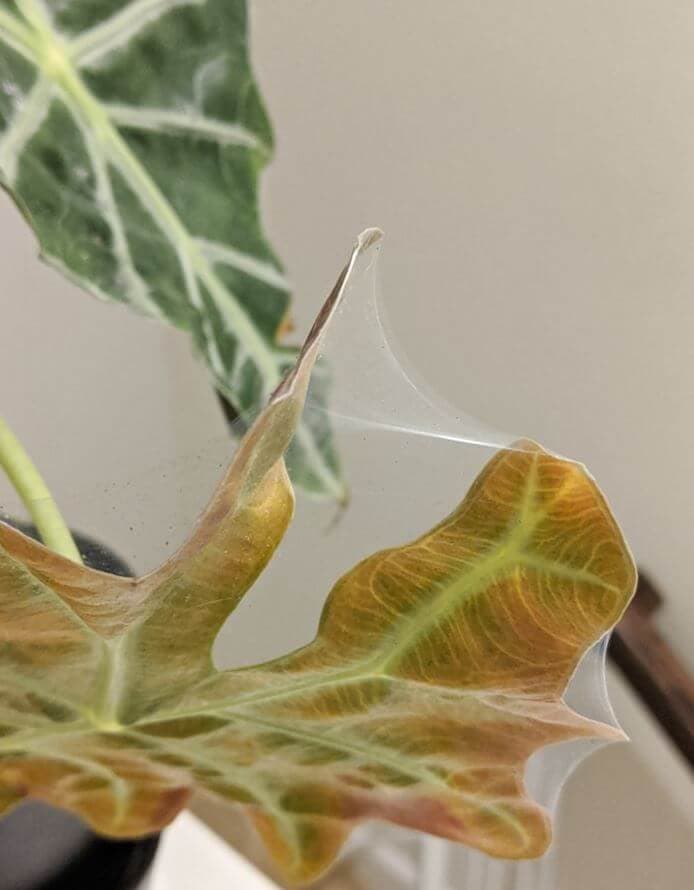Last Updated on August 24, 2023 by a Friendly Gardener
For indoor gardeners, nothing can be more troublesome than a pest infestation. Apart from the damage pests can do to an individual plant, they can spread quickly to other houseplants. Alocasias, like most houseplants, are susceptible to infestations, particularly those of spider mites. It’s crucial to prevent spider mites from arriving, identify the symptoms if they do, manage environmental humidity levels, and eliminate spider mites quickly if they attack your alocasia plant.
What are Spider Mites?

A spider mite is a minuscule arachnid that can and will feed on more than two hundred various species of plants. This pest has numerous varieties, with the most commonly seen type being the two-spotted spider mite. Spider mites love hot weather, particularly drought and dusty locations. Several spider mite species may limit feeding to just one or two plants, while many will feast on many.
Adult spider mites are very tiny, being barely 1/50 of an inch in length. Juvenile mites are even more microscopic, so these pests are practically invisible to the naked eye. You’ll need a magnifying glass to spot them.
Common types of spider mites include:
- Two-spotted spider mite (Tetranychusurticae)
- Southern red mite (Tetranychusevansi)
- Carmine spider mite (Tetranychuscinnabarinus)
- Cherry spider mite (Eotetranychuscarpini)
- Turkestan spider mite (Tetranychusturkestani)
- Strawberry spider mite (Tetranychusludeni)
Why Are Spider Mites Attracted to Alocasia Plants?
Spider mites thrive in dry, warm environments, so Alocasia plants are the perfect host for these pesky creatures. They are the most common type of houseplant pest to affect Alocasias.
Why Are Spider Mites Harmful to Alocasia Plants?
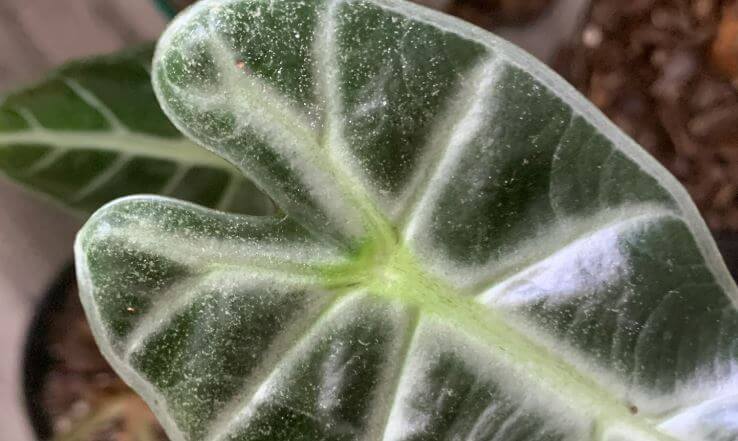
Spider mites can do quite a bit of damage in the garden regardless of whether it is an indoor or outdoor location. These pests can damage Alocasia plant parts, including stems and foliage. Spider mites will feed on the plant’s sap, turning foliage yellow and brown or red bumps may develop on the plant due to a toxin they inject during feeding. They often cover foliage with telltale webbing.
The spider mite is also well known as a disease transmitter because, as sap suckers, they weaken the Alocasia’s defenses against dangerous pathogens. They excrete honeydew, a sticky substance that rests on foliage surfaces and encourages the growth of sooty mold. This, too, will weaken the plant’s defenses. Their telltale webbing will also be a magnet for dust and debris, further inhibiting the Alocasia’s immune system and blocking necessary light for photosynthesis.
The speckling and spotting of leaves and the appearance of patches are typical when mites infest an Alocasia. Tiny white and yellow stippling and more prominent brown and yellow spots will appear. Foliage yellowing entirely is another result of spider mite infestations. As the mites feed on the Alocasia’s sap, this will cause discoloration and the yellowing of leaves, weakening the plant and ruining its appearance. This is especially true of lower leaves, where the mites like to congregate.
Unabated feeding by spider mites can also cause your Alocasia plant to lose its leaves as the moisture and nutrients are removed. Foliage dries out and becomes brittle, finally dropping from the plant. The extensive damage that spider mites cause can also result in stunted growth due to the lack of nutrients and the reduced sunlight available to your Alocasia.
Spider Mite Infestation Symptoms on Alocasia Plants
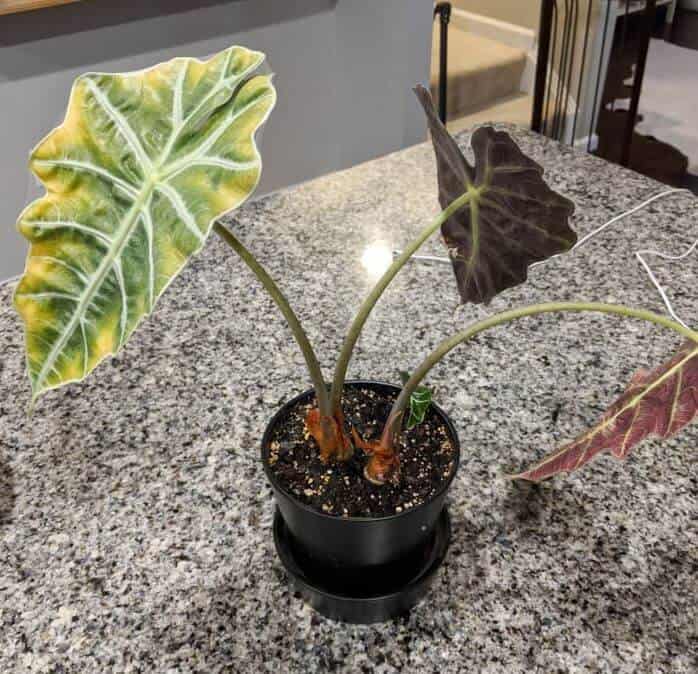
Initially, spider mites are extremely difficult to detect due to their size. Webbing indicates that these mites have taken up residence on your Alocasia.
Evidence of the presence of a spider mite infestation on your Alocasia plant may also include:
- Miniscule white and yellow stippling on foliage
- Spider webbing on leaves and stems
- Discolored, yellow, or brown leaves
- Drooping foliage
- Leaf edge scorching
- Leaf drop
Preventing Spider Mite Infestations of Alocasia Plants
Getting rid of spider mites can begin with effective prevention. If you are considering acquiring an Alocasia plant, choose an Alocasia species with more robust resistance to spider mites. This can aid in reducing the probability of an infestation.
Environmental conditions should also be considered. Alocasias enjoy warm, moderately humid locations with consistent moisture. When conditions are warm and dry with low humidity levels, this creates the perfect environment for spider mites to arrive, proliferate, and severely damage your plant.
Selecting a location with comfortable humidity and away from direct bright sunlight can reduce the probability of an infestation. Maintaining consistent humidity levels and wiping foliage with a damp cloth can aid in limiting environmental risks. Use a space humidifier or a pebble tray beneath your Alocasia to raise the humidity around your plant.
How to Get Rid of Spider Mites on Alocasias
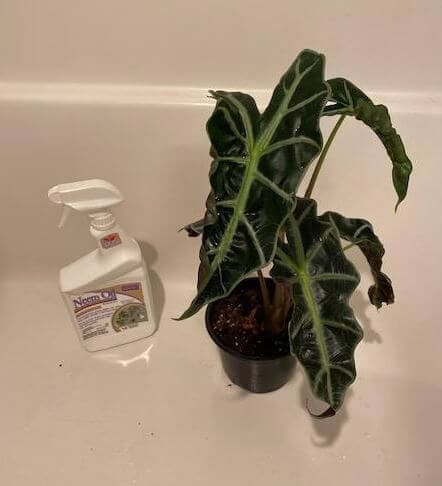
Webbing, stunted growth, stippling, patches, and leaf discoloration can all point to a spider mite infestation. Don’t forget to check the undersides of leaves for symptoms. If you find evidence of a spider mite infestation, it is crucial that you isolate the plant immediately and begin treatment.
To treat spider mites on Alocasia, foliage, and stems should be wiped down with an insecticidal soap solution or organic Neem oil. This means treating the topsides, undersides, and stems of the plant. You can spray your Alocasia plant with either of these products to target and kill spider mites. All affected and damaged leaves should be removed as they will not recover. Repeat the treatment several times, as these pests can be challenging to eliminate.
Remedies for Eliminating Spider Mite Infestations on Alocasias
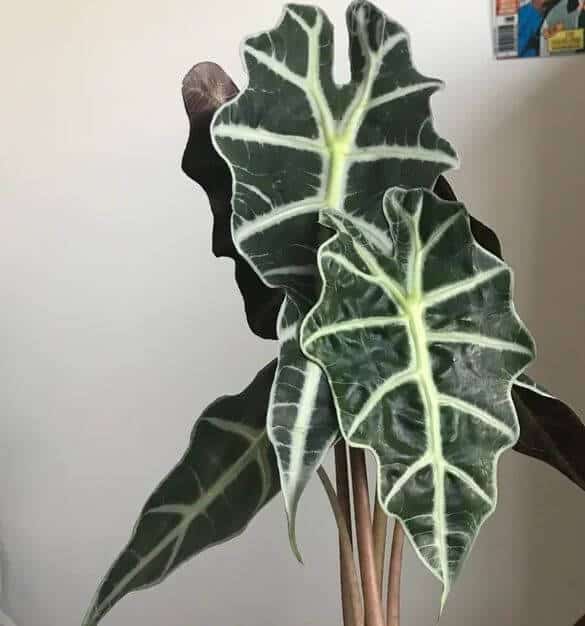
- Insecticidal soap is a natural remedy that will kill spider mites upon contact
- Neem oil – a natural insecticide and fungicide that will disrupt reproduction and reduce the population.
- Horticultural oil is a mineral oil that works well on Alocasia plants. It will smother pests, killing them.
- Chemical pesticide for spider mite infestations.
- Increased humidity and air circulation can reduce spider mite populations and infestations.
Spider mites can also infest the plant’s soil, so treat it as well, or you can repot your plant or replace the top layer of soil with fresh potting mix.

